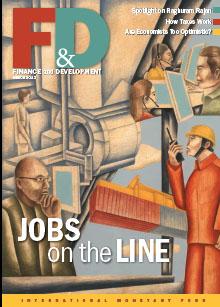
Typical street scene in Santa Ana, El Salvador. (Photo: iStock)
IMF Survey : Jobs Slowly Recovering From Crisis, Favoring Higher Skills
February 26, 2015
- Global employment finally recovering from crisis, albeit unevenly
- Migration, technology pushing workers to higher-skilled jobs
- Globalization and technology exacerbating inequality
Today’s job market demands more specialized skills, but migration and technology are helping—not hurting—chances of high-quality employment, according to the March 2015 issue of Finance & Development (F&D) magazine.

Migration and technology are driving employment toward higher-skilled jobs (illustration: Richard Downs)
JOBS ON THE LINE
30 million jobs, mostly in advanced economies, were lost during the Great Recession, writes the IMF’s Prakash Loungani in the latest issue of F&D. The world has since recovered slowly and unevenly, with global unemployment finally falling back to its pre-recession rate of 5 1/2 percent.
But the situation remains grim in much of Europe, especially for youth, says the IMF’s Angana Banerji. Most of the increase in youth unemployment stems from feeble economic growth, Banerji’s research finds, so the policy priority should be to boost demand. Indeed, the European Central bank is easing monetary policy and countries are investing in public infrastructure projects.
The story is different in sub-Saharan Africa, where economic growth has been strong and unemployment is relatively low. F&D’s Bruce Edwards writes that there the problem is “transforming the job market from one that has kept people working in small informal jobs and on farms—often for little or no pay—to one that offers more opportunities in the manufacturing and service sectors.”
With sub-Saharan Africa’s working-age population set to double by 2050, it’s urgent that businesses—whether formal or informal—provide many more jobs, and soon. Larger companies would have the advantage of providing tax revenue and social programs such as pensions and health care, but for now, any new jobs would be embraced, wherever they come from.
Moving out
Over 200 million people are unemployed worldwide. No surprise then that some fear immigrants and robots will take the jobs they so desperately need. But obstacles to immigration—geographic, linguistic, and bureaucratic—mean the share of migrants has remained stable since 1960 at about 3 percent of the global population. The limited globalization of the labor force means large wage gaps persist between countries that send migrants and those that receive them; migration has little impact on wages.
Migrants often get blamed for flooding the job market, but the World Bank’s ÇaÄŸlar Özden writes that they rarely take jobs from natives. If anything, they tend to nudge local workers into higher-skilled and better-paying jobs—as managers for example. Low-skilled migrant workers offer household help that allows educated women to work while their children are young.
Immigration does create jobs, with migrants performing the jobs natives are either unwilling or unqualified to perform. But there are also losers in the process and those are the stories we hear more about. Those who are too old to learn new skills or at the bottom rung of the ladder will lose out to foreign workers.
The largest economic benefit of migration for a host country is lower prices for consumers.
Given the pluses of immigration, recipient countries are wise to encourage it, while enforcing the taxation of immigrants' income and charging administrative fees to employers for visas, Özden recommends. Then these revenues can pay for skills development of some natives and unemployment insurance for others who cannot be retrained.
No robot takeover
Nor can joblessness be blamed on technology, says James Bessen of Boston University. Sometimes new technologies eliminate jobs altogether, but his research finds that technology today creates demand for different capabilities, displacing workers to different jobs that require new skills.
Only in advanced economies’ manufacturing sectors are jobs being eliminated—and these losses are offset by new jobs in other sectors. For example, the introduction of automatic teller machines in the United States led to more branches being opened, resulting in no fewer teller jobs but more branch manager jobs. People skills and those that complement the new technology are more in demand than ever.
But new technology does lead to stagnant wages for ordinary workers and skills shortages for employers, heightening inequality.
Labor market trends
The ILO’s Ekkehard Ernst agrees. As workers move around the world and technology automates many activities, the benefits of globalization accrue disproportionately to the top and bottom of the income scale. And as middle-income jobs stagnate or are cut, especially in manufacturing, inequality worsens. Ernst predicts “there will be better working conditions and higher salaries, but probably only for those who possess the right skills.”
Another influence exacerbating inequality has been the decline in unionization in recent decades. Research by the IMF’s Florence Jaumotte and Carolina Osorio Buitron finds that this phenomenon, combined with reductions in minimum wages, has fed the rise in the share of income going to the top 10 percent.

â– Also in the March 2015 issue of F&D; ITUC chief Sharan Burrow argues for a jobs- and wages-led global recovery; William R. White explains the shortcomings of the international monetary system; IMF fiscal chief Vitor Gaspar tells us what we can learn about fiscal policy and power politics from King Phillip II of Spain; and former F&D editor-in-chief Laura Wallace profiles Raghuram Rajan.


